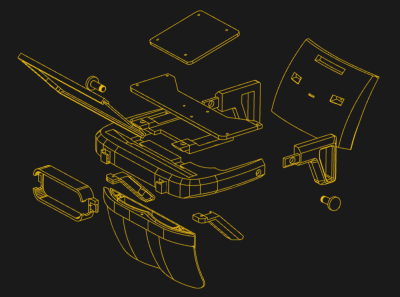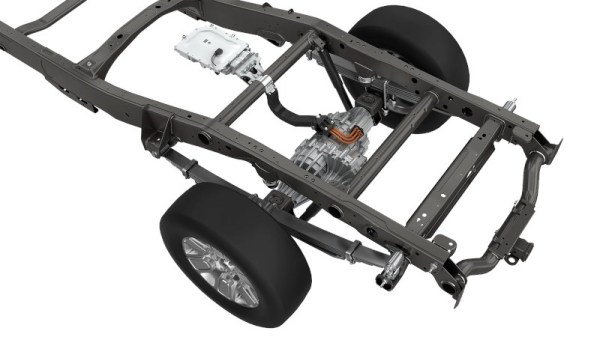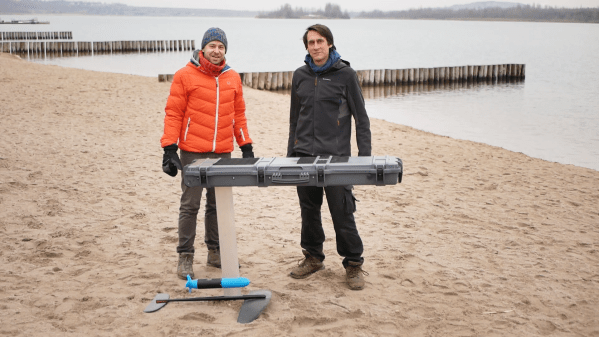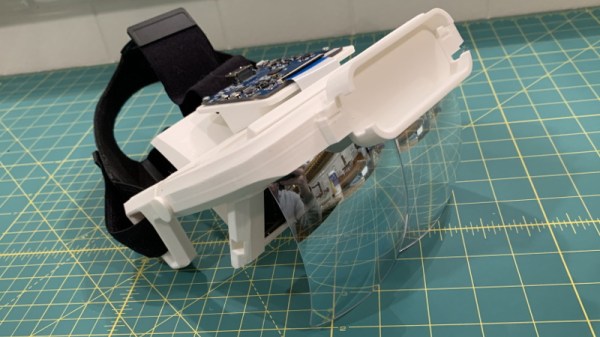Thus far, the majority of electric cars on sale have been aimed at commuters, fitting into the sedan and SUV segments of the marketplace. Going forward, there’s a very real need for electrification to touch the whole spectrum of automobiles, and that includes work vehicles like pickup trucks. A company called Magna have recently thrown their hat into the ring in just this space, developing a simple drivetrain that can be readily installed in pickup trucks without major modifications. Continue reading “Magna Announces Simple Drive Solution For Electric Pickup Trucks”
Weren’t We Supposed To Live In Plastic Houses In The Future?
Futurism is dead. At least, the wildly optimistic technology-based futurism of the middle years of the 20th century has been replaced in our version of their future by a much more pessimistic model of environmental challenges and economic woes. No longer will our flying cars take us from our space-age wonder-homes to the monorail which will whisk us through sparkling-clean cities to our robotised workplaces, instead while we may have a global computer network and voice controlled assistants we still live in much the same outdated style as we did decades ago. Our houses are made from wood and bricks by blokes with shovels rather than prefabricated by robots and delivered in minutes, and our furniture would be as familiar to a person from the 1950s as it is for us.
A Plastic Future That Never Quite Happened
There was a time when the future of housing looked remarkably different. Just as today we are busily experimenting with new materials and techniques in the type of stories we feature on Hackaday, in the 1950s there was a fascinating new material for engineers and architects to work with in the form of plastics. The Second World War had spawned a huge industry that needed to be repurposed for peacetime production, so almost everything was considered for the plastic treatment, including houses. It seemed a natural progression that our 21st century houses would be space-age pods rather than the pitched-roof houses inherited from the previous century, so what better way could there be to make them than using the new wonder material? A variety of plastic house designs emerged during that period which remain icons to this day, but here we are five or six decades later and we still don’t live in them. To find out why, it’s worth a look at some of them, partly as a fascinating glimpse of what might have been, but mostly to examine them with the benefit of hindsight.
Continue reading “Weren’t We Supposed To Live In Plastic Houses In The Future?”
MicroLEDs: Lighting The Way To A Solid OLED Competitor
We’re accustomed to seeing giant LED-powered screens in sports venues and outdoor displays. What would it take to bring this same technology into your living room? Very, very tiny LEDs. MicroLEDs.
MicroLED screens have been rumored to be around the corner for almost a decade now, which means that the time is almost right for them to actually become a reality. And certainly display technology has come a long way from the early cathode-ray tube (CRT) technology that powered the television and the home computer revolution. In the late 1990s, liquid-crystal display (LCD) technology became a feasible replacement for CRTs, offering a thin, distortion-free image with pixel-perfect image reproduction. LCDs also allowed for displays to be put in many new places, in addition to finally having that wall-mounted television.
Since that time, LCD’s flaws have become a sticking point compared to CRTs. The nice features of CRTs such as very fast response time, deep blacks and zero color shift, no matter the angle, have led to a wide variety of LCD technologies to recapture some of those features. Plasma displays seemed promising for big screens for a while, but organic light-emitting diodes (OLEDs) have taken over and still-in-development technologies like SED and FED off the table.
While OLED is very good in terms of image quality, its flaws including burn-in and uneven wear of the different organic dyes responsible for the colors. MicroLEDs hope to capitalize on OLED’s weaknesses by bringing brighter screens with no burn-in using inorganic LED technology, just very, very small.
So what does it take to scale a standard semiconductor LED down to the size of a pixel, and when can one expect to buy MicroLED displays? Let’s take a look. Continue reading “MicroLEDs: Lighting The Way To A Solid OLED Competitor”
Electric Vehicle 1900’s Style: New Leases On Old Tech
Excited about your new electric vehicle? Thomas Edison would be, too. He tried to produce electric vehicles for Ford around 1900. Petroleum-based vehicles dashed his dreams of the electric car, and the battery he wanted to use languished as a technological dead end. The batteries were long-lasting, sure, but they were expensive and had other problems, not the least of which was producing hydrogen gas. But that battery technology is receiving renewed interest today, because some of the things that made it a bad car battery make it good for alternate energy projects.
You wouldn’t think a century-old battery technology that was never very popular would make a comeback. But then again, who thought we’d see the return of bell-bottom pants or vinyl records? Continue reading “Electric Vehicle 1900’s Style: New Leases On Old Tech”
Shoot Above The Waves On This E-Foil Made From A Rifle Case
So you say you want to fly above the waves on an electric hydrofoil, but you don’t have the means to buy a commercial board. Or, you don’t have the time and skills needed to carve a board and outfit it with the motor and wing that let it glide above the water. Are you out of luck? Not if you follow this hackworthy e-foil build that uses a waterproof rifle case as the… hull? Board? Whatever, the floaty bit.
If you haven’t run across an e-foil before, prepare to suddenly need something you never knew existed. An e-foil is basically a surfboard with a powerful brushless motor mounted on a keel of sorts, fairly far below the waterline. Along with the motor is a hydrofoil to provide lift, enough to raise the board well out of the water as the board gains speed. They look like a lot of fun.
Most e-foils are built around what amounts to a surfboard, with compartments to house the battery, motor controller, and other electronics. [Frank] and [Julian] worked around the difficult surfboard build by just buying a waterproof rifle case. It may not be very hydrodynamic, but it’s about the right form factor, it already floats, and it has plenty of space for electronics. The link above has a lot of details on the build, which started with reinforcing the case with an aluminum endoskeleton, but at the end of the day, they only spent about 2,000€ on mostly off-the-shelf parts. The video below shows the rifle case’s maiden voyage; we were astonished to see how far and how quickly the power used by the motor drops when the rifle case leaves the water.
Compared to some e-foil builds we’ve seen, this one looks like a snap. Hats off to [Frank] and [Julian] for finding a way to make this yet another hobby we could afford but never find time for.
Continue reading “Shoot Above The Waves On This E-Foil Made From A Rifle Case”
Hershey Fonts: Not Chocolate, The Origin Of Vector Lettering
Over the past few years, I kept bumping into something called Hershey fonts. After digging around, I found a 1967 government report by a fellow named Dr. Allen Vincent Hershey. Back in the 1960s, he worked as a physicist for the Naval Weapons Laboratory in Dahlgren, Virginia, studying the interaction between ship hulls and water. His research was aided by the Naval Ordnance Research Calculator (NORC), which was built by IBM and was one of the fastest computers in the world when it was first installed in 1954.
The NORC’s I/O facilities, such as punched cards, magnetic tape, and line printers, were typical of the era. But the NORC also had an ultra-high-speed optical printer. This device had originally been developed by the telecommunications firm Stromberg-Carlson for the Social Security Administration in order to quickly print massive amounts of data directly upon microfilm.
Continue reading “Hershey Fonts: Not Chocolate, The Origin Of Vector Lettering”
Triton AR Headset Blends Stock And Printed Parts
Augmented reality (AR) and natural gesture input provide a tantalizing glimpse at what human-computer interfaces may look like in the future, but at this point, the technology hasn’t seen much adoption within the open source community. Though to be fair, it seems like the big commercial players aren’t faring much better so far. You could make the case that the biggest roadblock, beyond the general lack of software this early in the game, is access to an open and affordable augmented reality headset.
Which is precisely why [Graham Atlee] has developed the Triton. This Creative Commons licensed headset combines commercial off-the-shelf components with 3D printed parts to provide a capable AR experience at a hacker-friendly price. By printing your own parts and ordering the components from AliExpress, basic AR functionality should cost you $150 to $200 USD. If you want to add gesture support you’ll need to add a Leap Motion to your bill of materials, but even still, it’s a solid deal.

The trick here is that [Graham] is using the reflectors from a surprisingly cheap AR headset designed to work with a smartphone. By combining these mass produced optics with a six inch 1440 x 2560 LCD panel inside of the Triton’s 3D printed structure, projecting high quality images over the user’s field of view is far simpler than you might think.
If you want to use it as a development platform for gesture interfaces you’ll want to install a Leap Motion in the specifically designed socket in the front, but otherwise, all you need to do is plug in an HDMI video source. That could be anything from a low-power wearable to a high-end gaming computer, depending on what your goals are.
[Graham] has not only provided the STLs for all the 3D printed parts and a bill of materials, but he’s also done a fantastic job of documenting the build process with a step-by-step guide. This isn’t some theoretical creation; you could order the parts right now and start building your very own Triton. If you’re looking for software, he’s also selling a Windows-based “Triton AR Launcher” for the princely sum of $4.99 that looks pretty slick, but it’s absolutely not required to use the hardware.
Of course, plenty of people are more than happy to stick with the traditional keyboard and monitor setup. It’s hard to say if wearable displays and gesture interfaces will really become the norm, of they’re better left to science fiction. But either way, we’re happy to see affordable open source platforms for experimenting with this cutting edge technology. On the off chance any of them become the standard in the coming decades, we’d hate to be stuck in some inescapable walled garden because nobody developed any open alternatives.


















